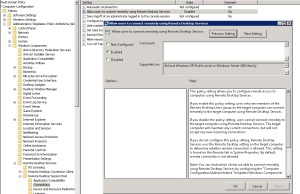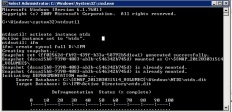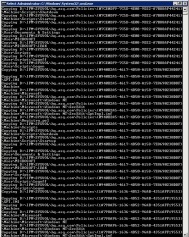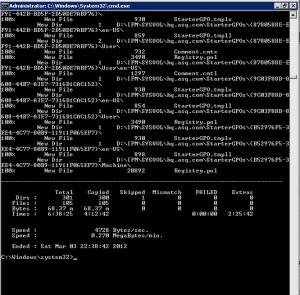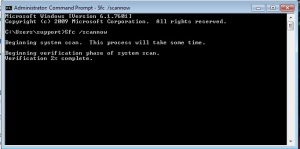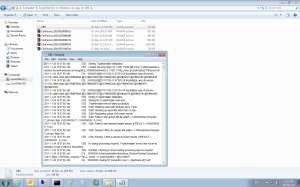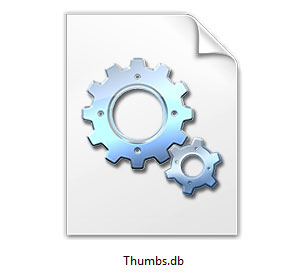Home directory:
Home folders are created automatically when the user’s account is
created and an administrator has enabled the use of home folders. You
change the home folders for the user afterwards, but we are all about
making the Admin’s life easier.
Create the folder and enable sharing

As you can see we create the share name and added a dollar sign ($) to the end.
Next, we’ll configure the share permissions. It is important to note
that there is a difference in the default permissions for a share
between Windows NT/Windows 2000 and Windows Server 2003. By default,
Windows 2000 gives the Everyone group Full Control permissions. Windows
Server 2003 gives the Everyone group Read permissions. However, we’ll
change this to:
Administrators: Full Control
System: Full Control
Authenticated Users: Full Control

If you expect or want users to be able to select their home directory
to be available while they are not connected to the network (also known
as
Offline Files), then you’ll want to make sure you turn on Offline file caching of the HOME$
share. You do this by:
1. Click Offline Settings on Windows 2000 or Caching on Windows Server 2003 or later, which is located on the Sharing tab.
2. Click Only the files and programs that users specify will be available offline. If you would like more information on the different options and what they mean you can click here.
3. Then click OK.
NOTE: You should consider configuring Offline Files settings even if
you do not want users to work with files while they are not connected to
the network—you’ll want to disable Offline Files by clicking
Files or programs from the share will not be available offline.
Configuring NTFS Permissions
Now we need to configure the NTFS permissions, so we need to be on the “Security” tab of the folder we created earlier.
1. Turn off inheritance on the folder and copy the permissions. You do this by:
a. Click the Advanced button found on the Security tab.
b. Clear Allow inheritable permissions to propagate to this object check box in the Advanced Security Settings dialog box.
c. Click Copy when prompted by the Security dialog box.
2. Click
OK to return to the
Security tab. Ensure we have the following permissions set:
Administrators: Full Control
System: Full Control
Creator Owner: Full Control
Authenticated Users: Read & Execute, List Folder Contents, Read
3. Change permissions for Authenticated Users so they cannot access other users’ folders. You do this by:
a. Click Advanced on the Security tab.
b. Click Authenticated Users, and then click Edit.
c. On the Permissions Entry for HOME dialog box, drop down the Apply onto and select This folder only.
d. Click OK twice.
Here is a screen shot of this step:

We now have the permissions configured properly. Next, let’s create a
user and specify the home folder location. This is done by going to the
Profile tab of the user account in Active Directory Users and Computers. In the following screen shot shows an example of a drive mapping.

Yep, the TOM folder got created without a problem:

When we look at the permissions of the TOM folder we see the following:

We see that only Administrators, System, Tom, and Creator Owner have permissions to the folder. Other users do not.
Roaming Profile: Configuring
roaming profiles uses the same procedure as the home folder share,
except for one difference. You should disable Offline Files and you
should always hide the profile share using a dollar sign ($).
Since the setup is pretty much exactly the same (except for the share
name) so I’m not going to bore you with the same steps as earlier.
The main difference between the roaming profile folder and the home
folder is that the roaming profile folder is not created until the user
logs on and then logs off. Windows creates the profile directory and
copies the profile to the share once the user has completed one
successful logon and logoff.
You configure the profile location on the
Profile or
Terminal Services Profile
tab within Active Directory Users and Computers. Type a UNC path to
where Windows should create the user profile. The following screen shot
gives you an example a user account configured with a profile path.
 Folder Redirection:
Folder Redirection: For
the most part the share and NTFS permissions are the same as the Home
folder configuration except we need to replace Authenticated Users with
the Everyone group. This is required for Windows to automatically create
the redirected folders. These two KB articles provide more information:
291087 Event ID 101 and Event ID 1000 Messages May Be Displayed When Folder
http://support.microsoft.com/?id=291087 274443 How to dynamically create security-enhanced redirected folders by using
http://support.microsoft.com/?id=274443
Create the folder and enable sharing
So, we need to create a folder on a file server and enable it for
sharing, again I would recommend that you hide the share using the
dollar sign ($) at the end of the share name.

If you expect or want users to be able to select their home directory
to be available while they are not connected to the network (also known
as
Offline Files), then you’ll want to make sure you turn on Offline file caching of the HOME$ share. You do this by:
1. Click
Offline Settings on Windows 2000 or
Caching on Windows Server 2003 or later, which is located on the
Sharing tab.
2. Click
Only the files and programs that users specify will be available offline. If you would like more information on the different options and what they mean you can click
here.
3. Then click
OK.
We will also need to set the following permissions for the share:
Administrators: Full Control
System: Full Control
Everyone: Full Control

Configuring NTFS Permissions
We need to configure NTFS permissions for the newly created folder.
You’ll want to remove inheritance from this folder, as we did when
configuring home folders.
1. Turn off inheritance on the folder and copy the permissions. You do this by:
a. Click the Advanced button found on the Security tab.
b. Clear Allow inheritable permissions to propagate to this object check box in the Advanced Security Settings dialog box.
c. Click Copy when prompted by the Security dialog box.
2. Click
OK to return to the
Security tab. Ensure we have the following permissions set:
Administrators: Full Control
System: Full Control
Creator Owner: Full Control
Everyone: Read & Execute, List Folder Contents, Read
3. Now we need change the permissions a bit for “Everyone” so that
they do not have any permission to other users’ folders. This is done by
doing the following:
a. Click Advanced on the Security tab.
b.Click Everyone, and then click Edit.
c. On the Permissions Entry for FldrRedir dialog box, drop down Apply onto and select This folder only.
d. Click OK twice.
Here is a screen shot of this step:

4. Configuring Folder Redirection settings within Group Policy:
a. Use the Group Policy Management Console (GPMC) and edit the GPO
containing the Folder Redirection settings you want modified. Configure
each from the following list to use the Basic – Redirect everyone’s folder to the same location
Folder Redirection setting. Type the UNC path listed in the table into
the Root Path setting for each folder listed in the following table.
|
Redirected Folder
|
UNC Path
|
|
Application Data
|
\\contoso-rt-mem1\FldrRedir$
|
|
Desktop
|
\\contoso-rt-mem1\FldrRedir$
|
|
My Documents
|
\\contoso-rt-mem1\FldrRedir$
|
|
Start Menu
|
\\contoso-rt-mem1\FldrRedir$
|
Here is a screen shot of Application Data being redirected:

You can see that Windows shows you the entire path used for the
Folder Redirection. So although we didn’t specify the user’s name in the
Root Path, the redirection example shows the folder path as: \\contoso-rt-mem1\FldrRedir$\Clair\Application Data
b. By default, Administrators do not have permissions to users’
redirected folders. If you require the ability to go into the users
folders you will want to go to the “Settings” Tab, and uncheck: "Grant
the user exclusive rights to" on each folder that is redirected. This
allows Administrators to enter the users redirected folder locations
without taking ownership of the folder and files.



